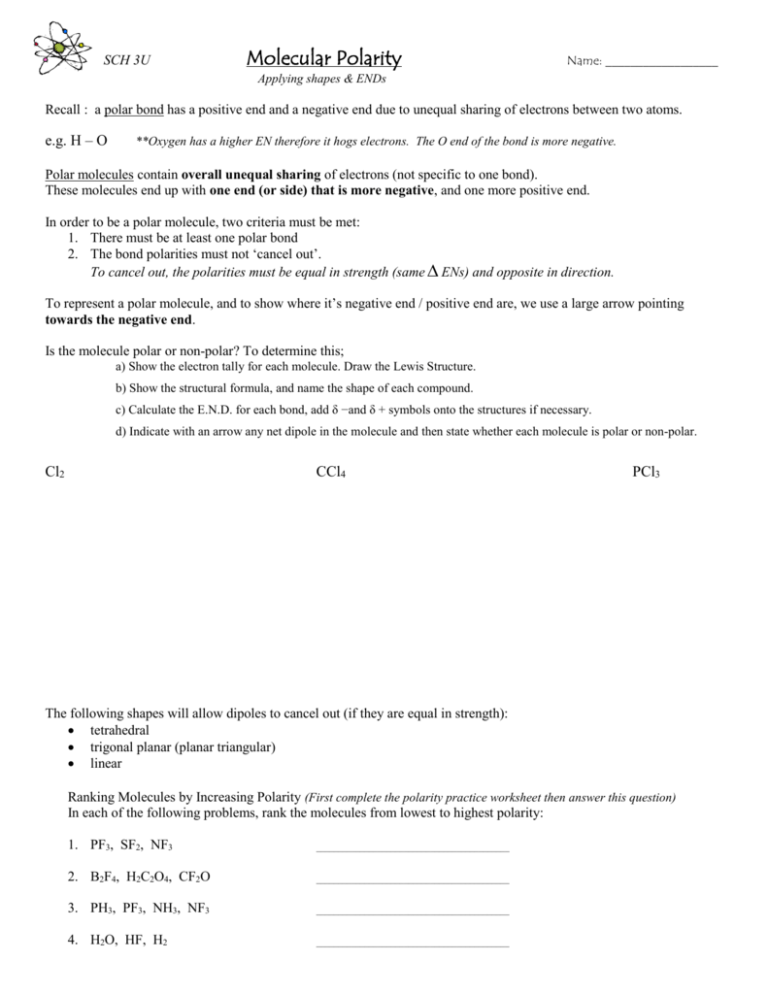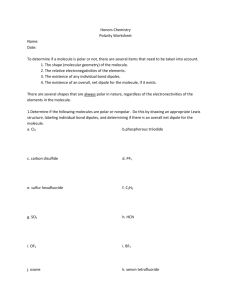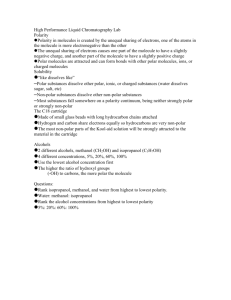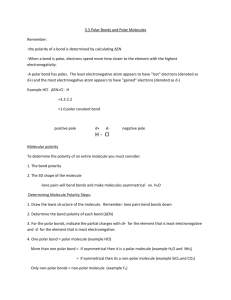Molecular Polarity - Norbraten
advertisement

SCH 3U Molecular Polarity Name: __________________ Applying shapes & ENDs Recall : a polar bond has a positive end and a negative end due to unequal sharing of electrons between two atoms. e.g. H – O **Oxygen has a higher EN therefore it hogs electrons. The O end of the bond is more negative. Polar molecules contain overall unequal sharing of electrons (not specific to one bond). These molecules end up with one end (or side) that is more negative, and one more positive end. In order to be a polar molecule, two criteria must be met: 1. There must be at least one polar bond 2. The bond polarities must not ‘cancel out’. To cancel out, the polarities must be equal in strength (same ENs) and opposite in direction. To represent a polar molecule, and to show where it’s negative end / positive end are, we use a large arrow pointing towards the negative end. Is the molecule polar or non-polar? To determine this; a) Show the electron tally for each molecule. Draw the Lewis Structure. b) Show the structural formula, and name the shape of each compound. c) Calculate the E.N.D. for each bond, add δ −and δ + symbols onto the structures if necessary. d) Indicate with an arrow any net dipole in the molecule and then state whether each molecule is polar or non-polar. Cl2 CCl4 PCl3 The following shapes will allow dipoles to cancel out (if they are equal in strength): tetrahedral trigonal planar (planar triangular) linear Ranking Molecules by Increasing Polarity (First complete the polarity practice worksheet then answer this question) In each of the following problems, rank the molecules from lowest to highest polarity: 1. PF3, SF2, NF3 ____________________________________________ 2. B2F4, H2C2O4, CF2O ____________________________________________ 3. PH3, PF3, NH3, NF3 ____________________________________________ 4. H2O, HF, H2 ____________________________________________ Polarity Practice For each of the following pairs of compound, determine which is most polar. This is determined by; drawing both the Lewis structure and structural formula for each compound and using VSEPR to determine the overall polarization of the molecule. Circle the chemical formula of the compound that is more polar. Be sure to include the following; a) Show the electron tally for each molecule. Draw the Lewis Structure. b) Show the structural formula, and name the shape of each compound. c) Calculate the E.N.D. for each bond, add δ −and δ + symbols onto the structures if necessary. d) Indicate with an arrow any net dipole in the molecule and then state whether each molecule is polar or non-polar. 1. methyl chloride (CHCl3) or methyl bromide (CHBr3) 2. hydrogen sulfide _________ or water __________ 3. hydrochloric acid __________ or hydroiodic acid __________ 4. silicon tetrabromide __________ or hydrogen cyanide _________ 5.sulfur difluoride __________ or carbon disulfide __________ 6. nitrogen trifluoride __________ or oxygen dichloride__________ 7. boron trihydride __________ or ammonia __________








